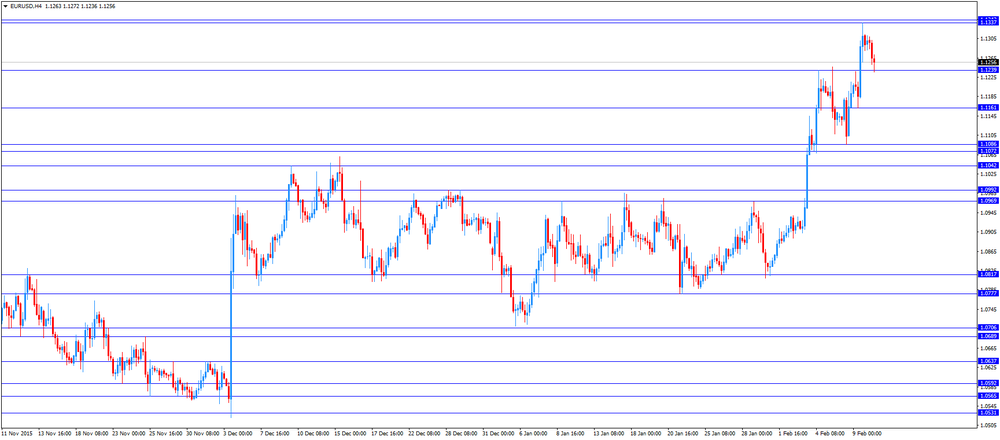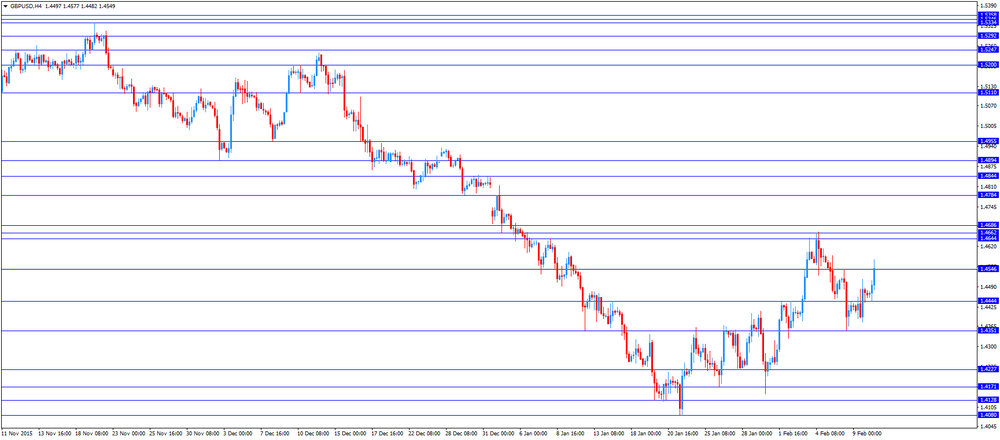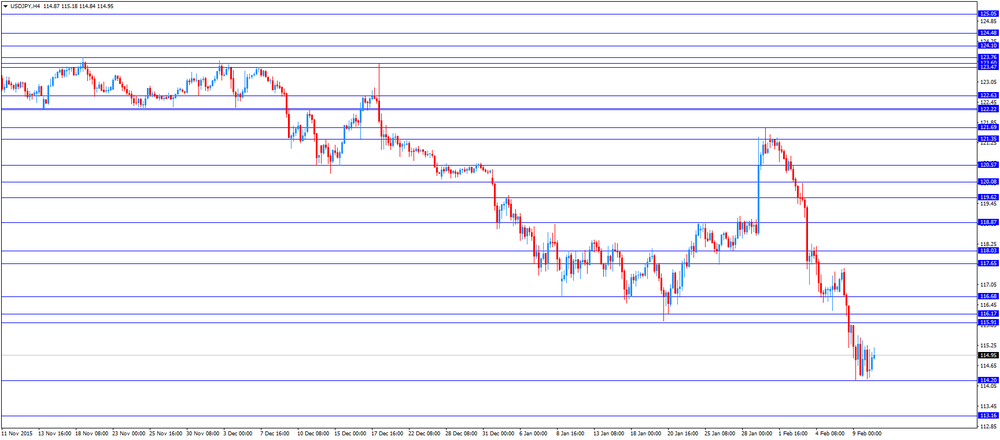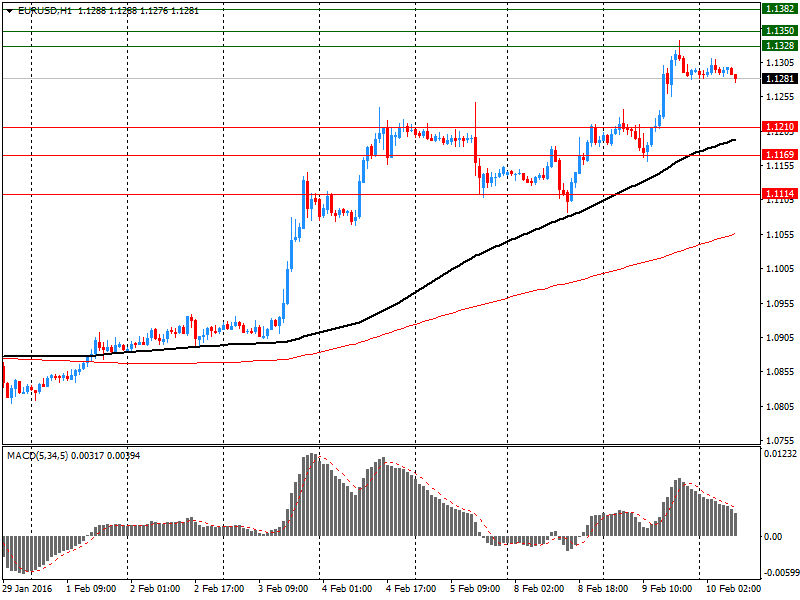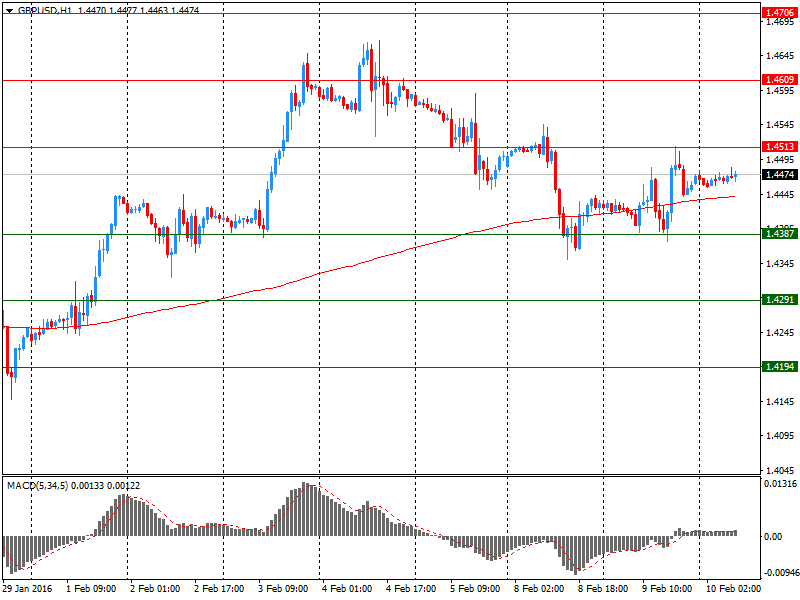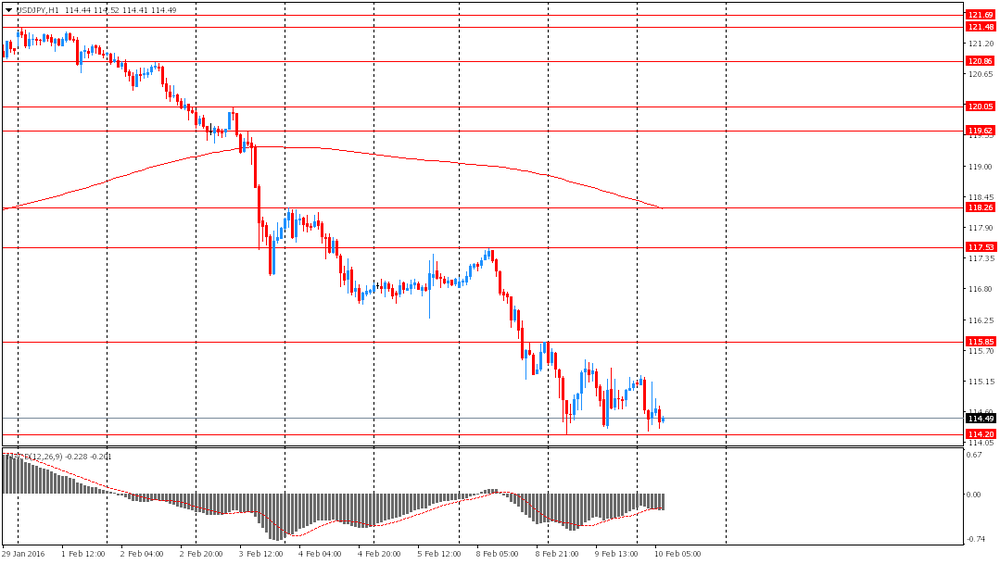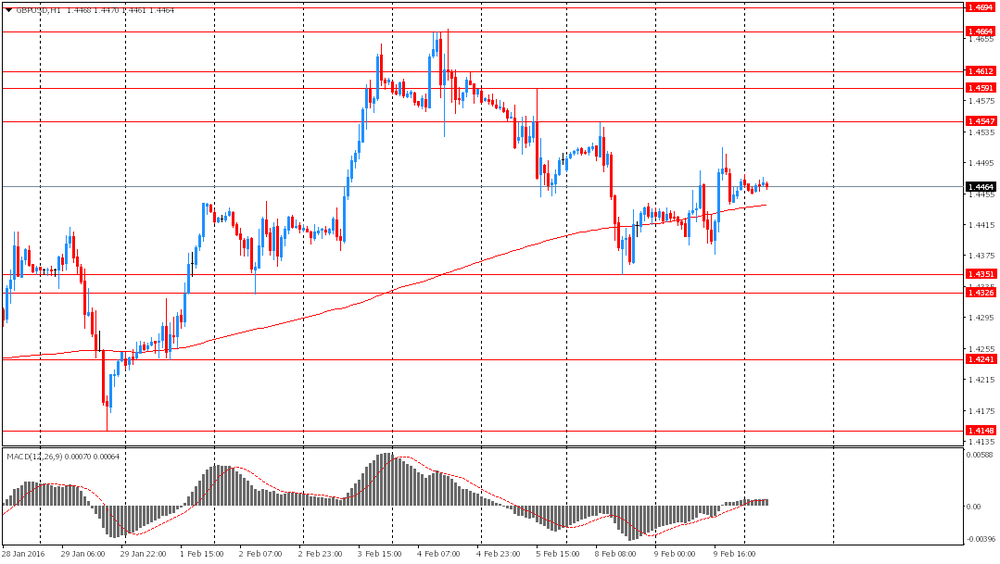Noticias del mercado
-
22:30
New Zealand: Business NZ PMI, January 57.9
-
20:20
American focus: The US dollar was trading mixed against major currencies
The dollar rose sharply against the euro, reaching a maximum at the same time yesterday, but then lost most of the positions. The reason for such dynamics were the statements of the Fed's Yellen. The head of the Central Bank reiterated that the pace of rate hikes will be gradual and that financial conditions in recent years are less supportive of economic growth. She also added that the low growth rate of average inflation associated with the fall in oil prices and other imported goods. In general, the Committee expects that inflation will remain low in the near future. According to representatives of the FOMC, forecasts the overall dynamics of interest rates on federal funds over the next 3 years has shifted to lower values: on average, it is expected that the rate will be 1.4% at the end of 2016, 2.4% at the end of 2017, and 3 3% at the end of 2018. "The economic conditions would justify a gradual increase in rates if economic growth is weaker than expected, then the need to increase slower rate." - Said Yellen. At the same time, the head of the Fed stressed that the regulator monetary policy stance in any case is not hard-coded in advance. "All things being equal, the lower the contribution of external factors to the growth of the US economy, will likely contribute to a gradual normalization of monetary policy," - she said. Yellen also indicated that the US strong dollar will increase exports of developed countries, which in turn can allow the Central Bank in Europe and Japan to hold at least a soft start to tighten policy, or it used to be.
The British pound fell against the dollar, returning to the level of opening of the session. In the course of trading influenced by the statements of the Fed's Yellen and weak data from NIESR. As it became known, the growth of Britain's economy slowed in the three months to January, which was due to weakness in the industrial sector. According to NIESR estimated that Britain's GDP grew by 0.4 percent over the three-month period (January) compared with an increase of 0.5 percent over the last three months of 2015. "Slower growth in the three months to January was mainly due to the weakness in the manufacturing sector at the end of last year", - the expert said NIESR James Warren. - Despite our assessment of a weak start in 2016, we still expect the economy to grow by 2.3 percent this year, mainly due to consumer spending. Nevertheless, the negative contribution from net trade is expected to be significant. "Recall the official data on industrial production, published earlier today pointed to a sharp decline in December, which proved to be the highest in more than three years. Industrial production fell 1.1 per cent, which was faster than the 0.8 percent decline in November. Economists had forecast that output will fall by 0.1 percent in December. It was the second consecutive decline in production. Manufacturing production decreased by 0.2 percent , confounding expectations for a rise of 0.1 percent. In November, production fell by 0.3 percent.
The Japanese yen has strengthened considerably against the US dollar, updating the maximum of 10 November 2014. Experts point out that the sharp fluctuations of oil prices forced investors to invest in safe-haven assets, namely the yen and gold. Also, demand for yen is probably due to the surplus of the current account balance of payments, and the deep liquidity of Japan's financial system. Today, Japanese Prime Minister Abe expressed his faith in the ability of the Bank of Japan head Kuroda properly conduct monetary policy. Abe said he would closely monitor the situation on the stock markets of Japan. He also added that the Japanese economy is on track and that many economists explain the fall in the stock market more external than internal factors.
Also on the dynamics of trade affected comments Fed Chairman Janet Yellen. She did not deny the possibility of new increases in the key rate, but noted that financial conditions have become more complex. In addition, she said, the hike may be delayed due to the strong dollar.
-
20:00
U.S.: Federal budget , January 55.2 (forecast 45)
-
18:21
Fed Chairwoman Janet Yellen: it is unlikely that the Fed will cut its interest rate soon as the risk of recession is low
The Fed Chairwoman Janet Yellen testified before the House Financial Services Committee on Wednesday that it is unlikely that the Fed will cut its interest rate soon as the risk of recession is low.
"We've not yet seen a sharp drop-off in growth, either globally or in the United States, but we certainly recognize that global market developments bear close watching," the Fed chairwoman noted.
Yellen was not sure if negative rate are legal as she was asked about the implementation of negative interest rates.
"We didn't fully look at the legal issues around that. I would say that remains a question that we still would need to investigate more thoroughly," she said.
-
16:30
U.S.: Crude Oil Inventories, February -0.754 (forecast 3.6)
-
16:19
NIESR’s gross domestic product rises by 0.4% in three months to January
The National Institute of Economic and Social Research (NIESR) released its estimate of gross domestic product (GDP) for the U.K. on Wednesday. The GDP estimate rose by 0.4% in three months to January, after a 0.5% growth in three months to December. December's figure was revised down from a 0.6% rise.
A softer growth was driven by a weakness in the production sector.
According to the NIESR, the U.K. economy is expected to expand 2.3% in 2016 and 2.7% in 2017.
"Despite our estimates indicating a subdued start to 2016, we do expect the economy to grow by 2.3 per cent this year, primarily driven by consumer spending. However, negative contributions from net trade are expected to weigh heavily on growth. There exist a number of downside risks that have the potential to exacerbate this, should they materialise," James Warren, NIESR Research Fellow, said.
-
16:05
Fed Chairwoman Janet Yellen: further interest rate hikes will depend on the incoming economic data
The Fed Chairwoman Janet Yellen said in her prepared remarks before the House Financial Services Committee that further interest rate hikes will depend on the incoming economic data, adding that interest rate hikes will be gradual.
She noted that there is a risk from developments abroad to the U.S. economy.
"The economic outlook is uncertain. Foreign economic developments, in particular, pose risks to U.S. economic growth," Yellen said.
The Fed chairwoman also said that "financial conditions in the United States have recently become less supportive of growth".
Yellen pointed out that a drop in stock markets, higher borrowing rates for riskier borrowers, and a further appreciation of the U.S. dollar could weigh on the outlook for economic activity and the labour market in the U.S.
She expects inflation to reach 2% target over the medium term, while the labour market is expected to continue to strengthen. Regarding the U.S. labour market, Yellen added that there remained some slack in labour markets.
-
16:00
United Kingdom: NIESR GDP Estimate, January 0.4%
-
14:48
Option expiries for today's 10:00 ET NY cut
EUR/USD 1.1000 (EUR 349m) 1.1075 (354m) 1.1100 (631m) 1.1300 (293m) 1.1370 (270m) 1.1390 (386m)
GBP/USD 1.4300 (GBP 699m) 1.4500(417m)
USD/CHF 1.0000 (USD 361m)
AUD/USD 0.6860-65 (AUD 269m) 0.6900 (235m) 0.7050 (745m)
USD/CAD 1.3845 (USD 420m) 1.3875 (460m) 1.3895-1.3900 (955m) 1.4100 (220m) 1.4115-25 (640m)
EUR/JPY 129.00 (1.17bn)
-
14:21
Foreign exchange market. European session: the British pound traded higher against the U.S. dollar despite the weak U.K. industrial production data
Economic calendar (GMT0):
(Time/ Region/ Event/ Period/ Previous/ Forecast/ Actual)
00:00 China Bank holiday
07:45 France Industrial Production, m/m December -0.9% 0.2% -1.6%
07:45 France Industrial Production, y/y December 2.8% 2.0%
09:30 United Kingdom Industrial Production (MoM) December -0.8% Revised From -0.7% -0.1% -1.1%
09:30 United Kingdom Industrial Production (YoY) December 0.7% Revised From 0.9% 1% -0.4%
09:30 United Kingdom Manufacturing Production (MoM) December -0.3% Revised From -0.4% 0.1% -0.2%
09:30 United Kingdom Manufacturing Production (YoY) December -1.2% -1.4% -1.7%
12:00 U.S. MBA Mortgage Applications February -2.6% 9.3%
The U.S. dollar traded mixed against the most major currencies ahead of the Fed Chairwoman Janet Yellen's testimony before the House Financial Services Committee at 15:00 GMT. Market participants will closely monitor her speech for hints regarding further interest rate hikes. They speculate that it is unlikely that the Fed will raise its interest rate at its March monetary policy meeting.
The euro traded lower against the U.S. dollar after the release of the weak data from the Eurozone. The French statistical office Insee its industrial production figures on Wednesday. Industrial production in France declined 1.6% in December, missing expectations for a 0.2% increase, after a 0.9% fall in November. It was the biggest drop since May 2014.
Manufacturing output decreased 0.8% in December, while construction output slid 1.6%.
On a yearly basis, the French industrial production climbed 2.0% in December, after a 2.8% gain in November.
The Italian statistical office Istat released its industrial production data on Wednesday. Industrial production in Italy fell at a seasonally-adjusted rate of 0.7% in December, after a 0.5% decline in November.
On a yearly basis, industrial production in Italy slid at a seasonally-adjusted rate of 1.0% in December, after a 1.1% increase in November. November's figure was revised up from a 0.9% gain.
The British pound traded higher against the U.S. dollar despite the weak U.K. industrial production data. The Office for National Statistics (ONS) released its manufacturing industrial production figures for the U.K. on Wednesday. Manufacturing production in the U.K. fell 0.2% in December, missing expectations for a 0.1% gain, after a 0.3% decrease in November.
Manufacturing output was mainly driven by a drop in the manufacture of wood, paper products and printing, which plunged by 2.1% in December.
On a yearly basis, manufacturing production in the U.K. decreased 1.7% in December, missing forecast of a 1.4% fall, after a 1.2% drop in November.
Industrial production in the U.K. slid 1.1% in December, missing forecasts of a 0.1% fall, after a 0.8% rise in November. It was the biggest monthly drop since 2012.
The decline was driven by falls in mining, oil and gas extraction and manufacturing.
On a yearly basis, industrial production in the U.K. decreased 0.4% in December, missing expectations for a 1.0% rise, after a 0.7% increase in November.
EUR/USD: the currency pair fell to $1.1236
GBP/USD: the currency pair rose to $1.4577
USD/JPY: the currency pair increased to Y115.18
The most important news that are expected (GMT0):
15:00 United Kingdom NIESR GDP Estimate January 0.6%
15:00 U.S. Federal Reserve Chair Janet Yellen Testifies
15:30 U.S. Crude Oil Inventories February 7.792 3.6
19:00 U.S. Federal budget January -14 45
21:30 New Zealand Business NZ PMI January 56.7
-
13:56
Orders:
EUR/USD
Offers: 1.1285 1.1300 1.1320 1.1350 1.1375-80 1.1400 1.1430 1.1450
Bids: 1.1250 1.1235 1.1220 1.1200 1.1185 1.1165 1.1150 1.1120 1.1100
GBP/USD
Offers: 1.4500 1.4520 1.4535 1.4550 1.4575-80 1.4600 1.4630 1.4650
Bids: 1.4470 1.4450 1.4425 1.4400 1.4385 1.4365 1.4350 1.4330 1.4300
USDCHF
Offers: 0.9860 0.9880 0.9900 0.9960 0.9980 1.0000
Bids: 0.9800 0.9780 0.9750 0.9730 0.9700
EURCHF
Offers: 1.1000 1.1020 1.1050 1.1080 1.1100 1.1120
Bids: 1.0950 1.0930 1.0900 1.0885 1.0860
USDCAD
Offers: 1.3880 1.3900 1.3920 1.3960 1.4000 1.4030 1.4050
Bids: 1.3840 1.3800 1.3780 1.3750 1.3730 1.3700
NZDUSD
Offers: 0.6680 0.6700 0.6730 0.6750
Bids: 0.6630 0.6600 0.6580 0.6550 0.6500
-
13:00
U.S.: MBA Mortgage Applications, February 9.3%
-
11:47
Producer prices in Japan fall 0.9% in January
The Bank of Japan (BoJ) released its Corporate Goods Price Index (CGPI) data on late Tuesday evening. Producer prices in Japan declined 0.9% in January, after a 0.3% fall in December.
Export prices fell 0.6% in January, while import prices declined 3.0%.
On a yearly basis, producer prices slid 3.1% in January, after a 3.4% drop in December.
Export prices dropped 5.6% year-on-year in January, while import prices plunged 16.6%.
-
11:40
HIA new home sales in Australia jump 6.0% in December
The Housing Industry Association (HIA) released its new home sales data for Australia on Wednesday. New home sales jumped 6.0% in December, after a 2.7% drop in November.
Sales of detached homes increased 2.2% in December, while sales for multi-units climbed 21.1%.
"Key leading indicators of new home building such as HIA-ACI New Home Sales and ABS Building Approvals and new housing finance are consistent with very healthy national construction volumes persisting throughout the first half of 2016. These indicators are also signalling a continuation in 2016 of very large differences in new housing conditions across the states," the HIA's chief economist Harley Dale said.
-
11:33
Industrial production in Italy drops 0.7% in December
The Italian statistical office Istat released its industrial production data on Wednesday. Industrial production in Italy fell at a seasonally-adjusted rate of 0.7% in December, after a 0.5% decline in November.
On a yearly basis, industrial production in Italy slid at a seasonally-adjusted rate of 1.0% in December, after a 1.1% increase in November. November's figure was revised up from a 0.9% gain.
Output of capital goods declined 1.6% year-on-year in December, output of consumer goods slid 1.0%, output of energy rose 0.4%, while output of intermediate goods decrease 2.6%.
In 2015 as whole, industrial production rose 1.0%.
-
11:18
French industrial production drops 1.6% in December
The French statistical office Insee its industrial production figures on Wednesday. Industrial production in France declined 1.6% in December, missing expectations for a 0.2% increase, after a 0.9% fall in November. It was the biggest drop since May 2014.
Manufacturing output decreased 0.8% in December, while construction output slid 1.6%.
Output in mining and quarrying, energy, water supply and waste management dropped 5.2% in December.
On a yearly basis, the French industrial production climbed 2.0% in December, after a 2.8% gain in November.
-
11:12
U.K. manufacturing and industrial production falls December
The Office for National Statistics (ONS) released its manufacturing industrial production figures for the U.K. on Wednesday. Manufacturing production in the U.K. fell 0.2% in December, missing expectations for a 0.1% gain, after a 0.3% decrease in November. November's figure was revised up from a 0.4% drop.
Manufacturing output was mainly driven by a drop in the manufacture of wood, paper products and printing, which plunged by 2.1% in December.
On a yearly basis, manufacturing production in the U.K. decreased 1.7% in December, missing forecast of a 1.4% fall, after a 1.2% drop in November.
Industrial production in the U.K. slid 1.1% in December, missing forecasts of a 0.1% fall, after a 0.8% rise in November. It was the biggest monthly drop since 2012.
November's figure was revised down from a 0.7% decrease.
The decline was driven by falls in mining, oil and gas extraction and manufacturing.
On a yearly basis, industrial production in the U.K. decreased 0.4% in December, missing expectations for a 1.0% rise, after a 0.7% increase in November. November's figure was revised down from a 0.9% gain.
-
10:44
Option expiries for today's 10:00 ET NY cut
EUR/USD 1.1000 (EUR 349m) 1.1075 (354m) 1.1100 (631m) 1.1300 (293m) 1.1370 (270m) 1.1390 (386m)
GBP/USD 1.4300 (GBP 699m) 1.4500(417m)
USD/CHF 1.0000 (USD 361m)
AUD/USD 0.6860-65 (AUD 269m) 0.6900 (235m) 0.7050 (745m)
USD/CAD 1.3845 (USD 420m) 1.3875 (460m) 1.3895-1.3900 (955m) 1.4100 (220m) 1.4115-25 (640m)
EUR/JPY 129.00 (1.17bn)
-
10:43
The White House downgrades its growth and inflation forecasts
The White House downgraded growth and inflation forecasts. The U.S. economy is expected to expand 2.6% in 2016, down from its previous forecast of a 3.0% rise, and 2.6% in 2017, down from its previous forecast of a 2.8% growth.
Inflation is expected to rise 1.5% in 2016, down from its previous forecast of 1.9%, and 2.1% in 2017 and 2018.
The White House forecasts the budget deficit to be 3.3% of GDP in 2016, down from its previous forecast of 2.3%, and 2.6% of GDP in 2017, down from its previous forecast of 2.2%.
The unemployment rate is expected to be 4.7% in 2016, 4.5% in 2017, and 4.6% in 2018.
-
10:37
Japanese Prime Minister Shinzo Abe defends the Bank of Japan’s monetary policy decisions
Japanese Prime Minister Shinzo Abe on Wednesday defended before the parliament the Bank of Japan's (BoJ) monetary policy decisions. He noted that he trusted the BoJ Governor Haruhiko Kuroda and he believe that inflation will reach 2% target.
Abe also said that a drop in markets was driven by overseas factors.
-
10:30
United Kingdom: Industrial Production (YoY), December -0.4% (forecast 1%)
-
10:30
United Kingdom: Manufacturing Production (YoY), December -1.7% (forecast -1.4%)
-
10:30
United Kingdom: Industrial Production (MoM), December -1.1% (forecast -0.1%)
-
10:30
United Kingdom: Manufacturing Production (MoM) , December -0.2% (forecast 0.1%)
-
10:12
Westpac’ consumer confidence index for Australia climbs 4.2% in February
Westpac Bank released its consumer confidence index for Australia on late Tuesday evening. The index climbed 4.2% in February, beating expectations for a 1.0% fall, after a 3.5% drop in January.
The index was mainly driven by a rise in the index tracking views on 'family finances vs a year ago', which jumped by 11.3% in February.
"The Reserve Bank Board next meets on March 1. Following the recent turmoil, markets are convinced that the Reserve Bank will be cutting rates by May, if not earlier," Westpac Chief Economist Bill Evans said.
"Today's report highlights that one of the Bank's most significant concerns of whether international developments will weigh on domestic demand will need more time to resolve," he added.
-
08:46
France: Industrial Production, y/y, December 2.0%
-
08:46
France: Industrial Production, y/y, December 2.0%
-
08:45
France: Industrial Production, m/m, December -1.6% (forecast 0.2%)
-
08:30
Options levels on wednesday, February 10, 2016:
EUR / USD
Resistance levels (open interest**, contracts)
$1.1382 (4125)
$1.1350 (3003)
$1.1328 (4946)
Price at time of writing this review: $1.1281
Support levels (open interest**, contracts):
$1.1210 (235)
$1.1169 (1151)
$1.1114 (3874)
Comments:
- Overall open interest on the CALL options with the expiration date March, 4 is 58591 contracts, with the maximum number of contracts with strike price $1,1000 (4946);
- Overall open interest on the PUT options with the expiration date March, 4 is 82702 contracts, with the maximum number of contracts with strike price $1,0900 (6742);
- The ratio of PUT/CALL was 1.41 versus 1.33 from the previous trading day according to data from February, 9
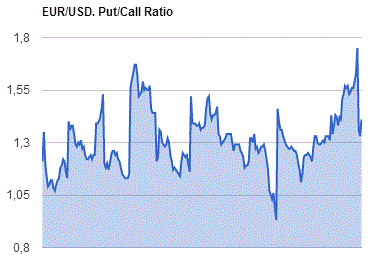
GBP/USD
Resistance levels (open interest**, contracts)
$1.4706 (1115)
$1.4609 (1047)
$1.4513 (885)
Price at time of writing this review: $1.4474
Support levels (open interest**, contracts):
$1.4387 (535)
$1.4291 (1832)
$1.4194 (1824)
Comments:
- Overall open interest on the CALL options with the expiration date March, 4 is 24859 contracts, with the maximum number of contracts with strike price $1,4300 (1430);
- Overall open interest on the PUT options with the expiration date March, 4 is 22832 contracts, with the maximum number of contracts with strike price $1,4350 (2660);
- The ratio of PUT/CALL was 0.92 versus 0.91 from the previous trading day according to data from February, 9
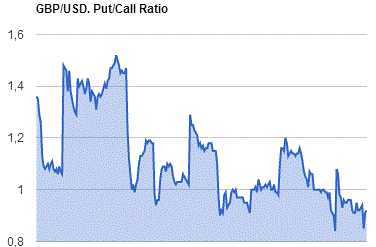
* - The Chicago Mercantile Exchange bulletin (CME) is used for the calculation.
** - Open interest takes into account the total number of option contracts that are open at the moment.
-
08:12
Foreign exchange market. Asian session: the pound little changed
The pound traded range-bound as market participants await official U.K. industrial production data for December. Preliminary January data have already confirmed slower growth in the fourth quarter of 2015. U.K. GDP expanded by 0.5% in Q4 2015 on a quarterly basis. Some economists are concerned that weak industrial data could lead to a downward revision of economic growth. Nevertheless many analysts believe that activity rose in the industrial sector at the end of the previous year.
Investors are also waiting for Federal Reserve Chairwoman Janet Yellen to speak later today and on Thursday. If Yellen signals that the central bank is unlikely to raise rates this year the dollar would most probably decline. Analysts expect neutral comments from Fed Chairwoman. According to a survey by Bloomberg, only 30% of analysts expect a rate hike in March compared to 93% at the end of 2015.
The Australian dollar climbed after Westpac reported consumer confidence rose in February. The corresponding index advanced by 4.2% to 101.3 in February compared to 97.3 in January. A reading above 100 suggests that there are more optimists than pessimists. The index has been above 100 for only five months in two years.
EUR/USD: the pair fluctuated within $1.1280-10 in Asian trade
USD/JPY: the pair fell to Y114.25
GBP/USD: the pair traded within $1.4455-75
The most important news that are expected (GMT0):
(time / country / index / period / previous value / forecast)
07:45 France Industrial Production, m/m December -0.9% 0.2%
07:45 France Industrial Production, y/y December 2.8%
09:30 United Kingdom Industrial Production (MoM) December -0.7% -0.1%
09:30 United Kingdom Industrial Production (YoY) December 0.9% 1%
09:30 United Kingdom Manufacturing Production (MoM) December -0.4% 0.1%
09:30 United Kingdom Manufacturing Production (YoY) December -1.2% -1.4%
12:00 U.S. MBA Mortgage Applications February -2.6%
15:00 United Kingdom NIESR GDP Estimate January 0.6%
15:00 U.S. Federal Reserve Chair Janet Yellen Testifies
15:30 U.S. Crude Oil Inventories February 7.792 3.6
19:00 U.S. Federal budget January -14 45
21:30 New Zealand Business NZ PMI January 56.7
-
01:02
Currencies. Daily history for Feb 9’2016:
(pare/closed(GMT +2)/change, %)
EUR/USD $1,1293 +0,89%
GBP/USD 1,4470 +0,27%
USD/CHF Chf0,9726 -1,47%
USD/JPY Y115,10 -0,64%
EUR/JPY Y129,98 +0,25%
GBP/JPY Y166,55 -0,36%
AUD/USD $0,7069 -0,23%
NZD/USD $0,6634 +0,12%
USD/CAD C$1,3865 -0,43%
-
00:30
Australia: Westpac Consumer Confidence, February 4.2% (forecast -1%)
-
